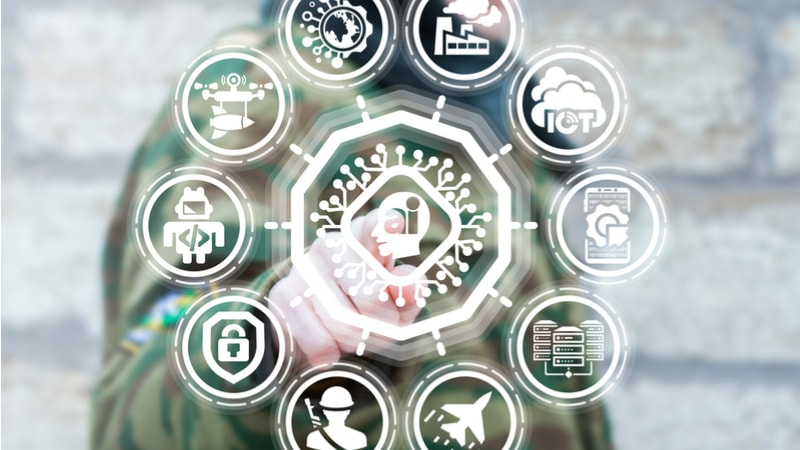
Top commanders responsible for cybersecurity operations in five of the U.S. military service branches listed out some of their top operational priorities during a panel discussion on May 2 at the AFCEA TechNet Cyber conference in Baltimore, with topics ranging from data security to workforce recruiting and retention emerging as common threads.
Army Priorities – Data Fabric
Lt. Gen. Maria Barrett, commanding general of U.S Army Cyber Command, talked about how the Army is moving quickly to operationalize data as a warfighting tool, and said, “we really need to start thinking about how you underpin all of that, all that data … it really gets down to building a data fabric that will support these types of exchanges.”
“How do you build this fabric really to operate and enable all that decision making … and get after data-driven decisions,” she asked. “If you’re not thinking about the security of this from the beginning, when you’re doing your development of the software that underpins this, to the deployment, where is it going to go in this environment, and then how are you going to sustain this and operate this from end to end?”
If those questions are aren’t answered properly, she indicated, “we’re going to really put at risk that commander’s decision dominance.”
“I hope the discussions that we’re having over the next couple of days here really get to the core of some of these things, because they’re absolutely vital for where the Department of Defense and the Army wants to go,” the general said.
Navy Priorities – C&C, Awareness, Cyber Effects
Angela Carter, deputy to commander, Joint Force Headquarters Cyber (Navy), said her organization is focused on delivering technology for the primary aims of assuring command and control, creating battle space and space domain awareness, and achieving cyber effects.
Assured command and control, she said, “includes encryption, securing our communication infrastructure and redundancy of systems, and cybersecurity.” She continued, “our ability to communicate securely is integral to us being able to fight,” adding, “we need to be able to ensure that those systems are secure, robust and redundant.”
“The second area … that we’re focused on is battle space and space domain awareness,” she said. “We’re leveraging our cyber and space capabilities in order to enhance our understanding of the physical battlefield.”
“The third area is cyber effects, and those include offensive and defensive capabilities that we will use to impact our adversary,” Carter said.
“In order to deliver these capabilities, Fleet Cyber Command needs innovation and partnerships,” she said. “We need creative solutions that easily integrate into our systems, networks and operations. However, we also need to be sure that that cybersecurity is built into all areas of collaboration.”
Air Force Priorities – Readiness
Air Force Lt. Gen. Kevin Kennedy, commander of Sixteenth Air Force and Air Forces Cyber, said that “readiness is our number one priority” within the organizations that he leads.
“When we’re talking about readiness, the big question we should all ask ourselves is ready for what,” he said. “The answer is pretty simple – ready to face the peer challenge that we have in the PRC [Peoples Republic of China], and to meet the key threat that we see unfolding right now in Eastern Europe” with Russian aggression. “We have to train, build capability, and develop doctrine to make sure that we can take care of those two things that are on our plate.”
“The next one is strengthened resilience across our force,” the general said. “This is resilience of our airmen as well as resilience of our systems … And as you know, this isn’t just about PACE planning of our systems, this is about the data requirements to execute our mission – and how do we get those in a disconnected, isolated, limited bandwidth environment that we think we’re going to be fighting in the Pacific, and thinking through that problem.”
“The next one is all focused on results,” he said, and talked about how to bring together the contributions of nearly 50,000 Air Force personnel involved with Sixteenth Air Force, and about driving modernization of capabilities and processes to support airmen at the tactical edge who have to execute on their missions.
Marine Corps Priority – Network Defense, Talent Management
Marine Maj. Gen. Joseph Matos III, deputy commander, Joint Force Headquarters Cyber (Marines), who has logged 30 years in the service, said, “when I first came in, it was an analog world … it was single- channel radio, it was analog systems … and now everything’s ubiquitous computers.”
“So I think one of the keys for senior leaders such as us is to set the stage for that next 30 years,” he said. “What’s this cyberspace world going to look like 30 years from now, because I know the radical changes that we’ve gone through in just the time that I’ve been in, and am really excited to see what would be in the future.”
He talked about priorities including “supporting, operating, defending the Marine Corps enterprise network and making sure it’s extended out, ready and available anytime, anyplace,” and making sure that the network is “defended against all threats coming towards it.”
Another big priority, Gen. Matos said, is talent management, which he described as “just making sure we have the quality Marines, we assess them, we train them, we retain them, and we make sure they’re ready to do the jobs they’re required to do both for the Marine Corps but also in support of” U.S. Cyber Command.
Coast Guard Priority – Port Protection
Coast Guard Captain Adam Morrison, deputy commander, Coast Guard Cyber Command, said the Coast Guard’s profile is unique in that it is a military branch, but the only one that is party of the Department of Homeland Security.
He talked about the command’s main lines of effort, including the responsibility for protecting the cyber domain around all U.S. ports, and internationally.
